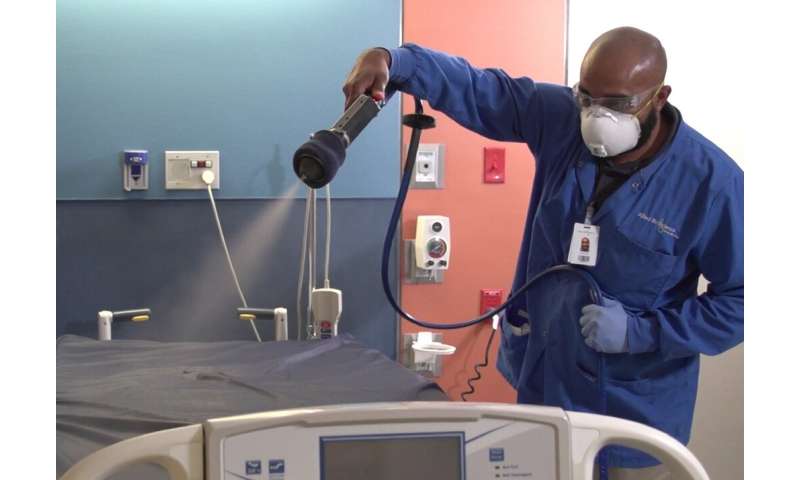Continuously active surface disinfectants may provide additional barrier against the spread of viruses

In the battle to slow or prevent the transmission of viruses, such as the novel coronavirus, continuously active disinfectants could provide a new line of defense, according to a recent University of Arizona study released on the health sciences preprint server MedRxiv.
While disinfecting high-contact surfaces is an important practice to prevent the spread of pathogens, these surfaces can be easily re-contaminated after the use of conventional surface disinfectants. Alternatively, continuously active disinfectants work to actively kill microorganisms and provide continued protection over an extended period of time.
While disinfecting high-contact surfaces is an important practice to prevent the spread of pathogens, these surfaces can be easily re-contaminated after the use of conventional surface disinfectants. Alternatively, continuously active disinfectants work to actively kill microorganisms and provide continued protection over an extended period of time.
"During the course of respiratory illnesses such as COVID-19, aerosols released during sneezing and coughing contain infectious viruses that will eventually settle onto various surfaces," said Luisa Ikner, associate research professor in the Department of Environmental Science and lead author of the study. "Factors including temperature, humidity and surface type can affect how long viruses such as SARS-CoV-2 will remain infectious after surface deposition."
"The only tools we have currently in reducing the environmental spread of viruses via surfaces are hand sanitizer, hand washing and the disinfection of surfaces," said Charles Gerba, a microbiologist and professor of environmental science in the College of Agriculture and Life Sciences. "This technology creates a new barrier in controlling the spread of viruses in indoor environments."
Gerba and his research team designed and conducted the study—which was funded by Allied BioScience, a company that manufactures antimicrobial surface coatings—to evaluate continuously active antimicrobial technology and its potential use against the transmission of viruses.
"We evaluated this technology by testing a modified antimicrobial coating against the human coronavirus 229E, which is one of the viruses that causes the common cold," Gerba said. "Even two weeks after the coating was applied, it was capable of killing more than 99.9% of the coronaviruses within two hours."
Human coronavirus 229E is similar in structure and genetics to SARS-CoV-2 but causes only mild respiratory symptoms. It can therefore be safely used as a model for SARS-CoV-2 to evaluate antiviral chemistries. The results from these experiments may provide new opportunities for controlling the environmental transmission of COVID-19.
"The standard practice of surface disinfection using liquid-based chemistries according to product label instructions can render many viruses—including the coronaviruses—noninfectious," Ikner said. "In contrast, high-touch surfaces treated with continuously active disinfectants are hostile environments to infectious viruses upon contact and demonstrate increasing effectiveness over time."
Continuously active disinfectant technology has been around for almost a decade but has been focused primarily on controlling hospital-acquired bacterial infections, such as invasive methicillin-resistant Staphylococcus aureus, or MRSA.
UArizona researchers from the Mel and Enid Zuckerman College of Public Health investigated the impact of antimicrobial surface coatings in reducing health care-associated infections in two urban hospitals. The results of that study were published in October and found a 36% reduction in hospital-acquired infections with the use of a continually active antimicrobial.
"As communities are reopening after weeks of stay-at-home restrictions, there is significant interest in minimizing surface contamination and the indirect spread of viruses," Gerba said.
Previous research on the environmental spread of viruses through contaminated surfaces modeled the spread of germs and the risk of infection in an office workplace. In that study, a contaminated push-plate door at the entrance of an office building led to the contamination of 51% of commonly touched surfaces and 38% of office workers' hands within just four hours. With the use of disinfecting wipes, environmental contamination was reduced to 5% of surfaces and 11% of workers' hands.
"Antimicrobial coatings could provide an additional means of protection, reducing the spread of coronaviruses in indoor environments and public places where there is continuous contamination," Gerba said. "We're evaluating a number of products right now and believe it may be the next major breakthrough.
I HAVE POSTED ANOTHER VERSION OF THIS EARLIER IN MY BLOG FROM ANOTHER SOURCE
No comments:
Post a Comment